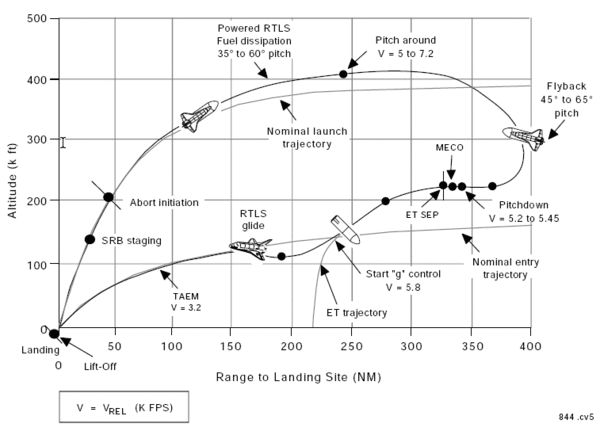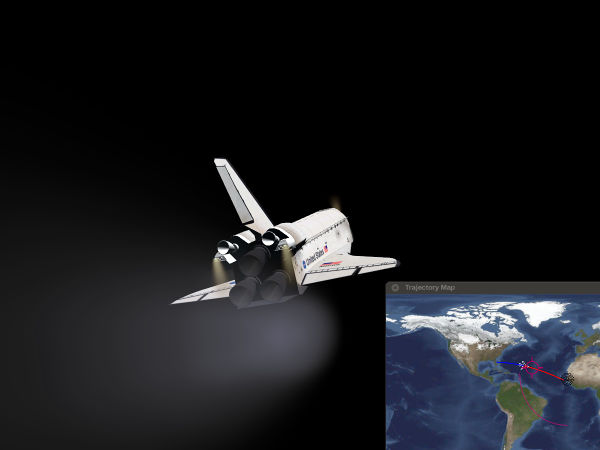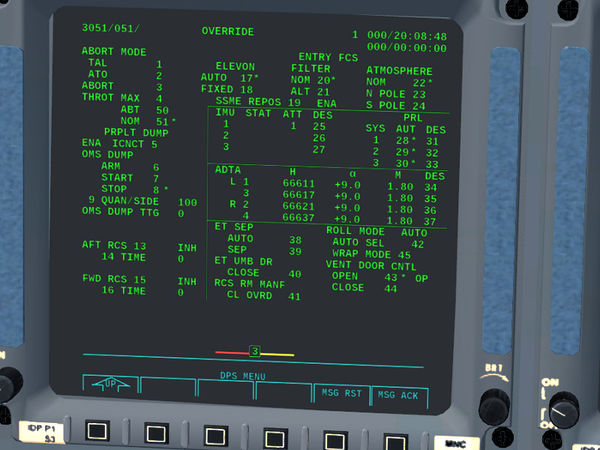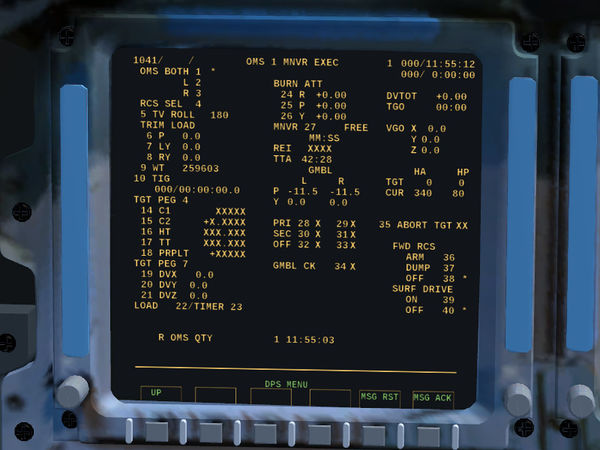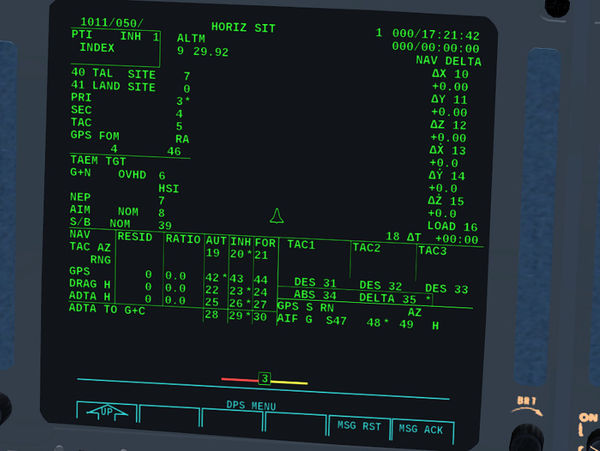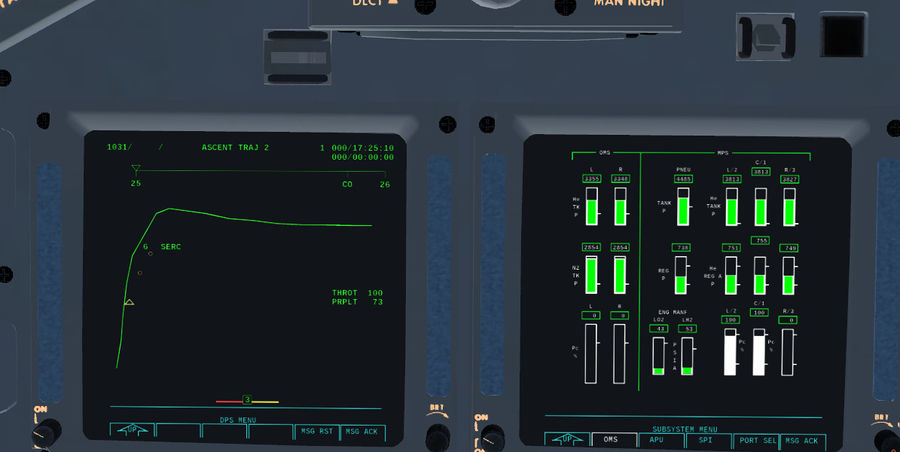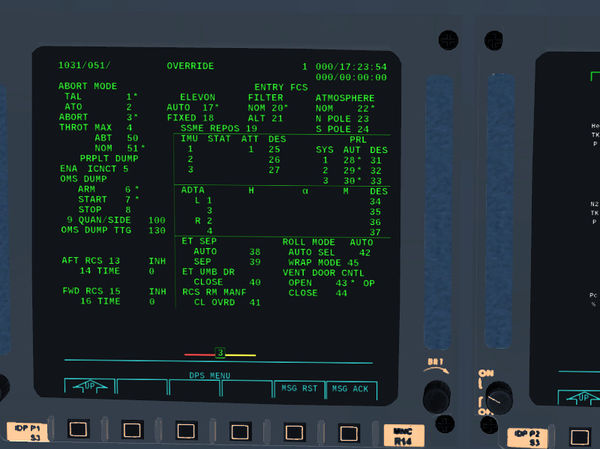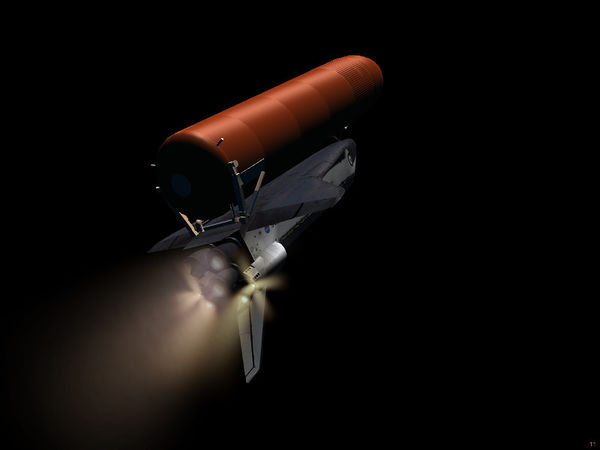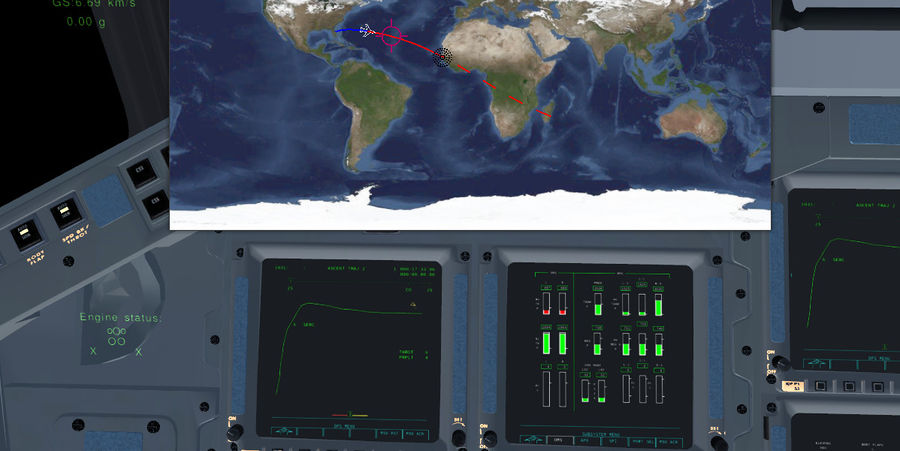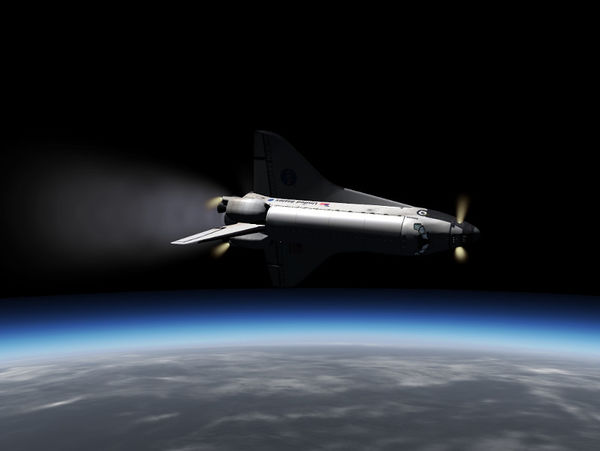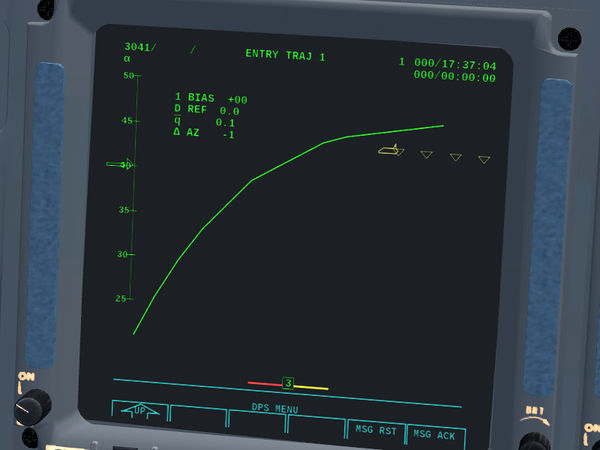Flying the Shuttle - Abort Procedures Overview
| Note This article refers to the SpaceShuttle in the FGAddon repository. |
| Space Shuttle |
|---|
| Main article |
| Technical |
| Checklists |
| Nominal Operations |
| Nominal Operations Advanced Tutorials |
| Intact Aborts |
| The other space shuttle |
Aborts are off-nominal procedures, to be executed in case something goes wrong. More specifically, the Space Shuttle abort procedures are designed to be executed during powered flight, to allow a safe return to Earth in case something goes badly wrong during launch. Since the FG Space Shuttle fully supports multiple failure scenarios, there is also corresponding support to execute abort procedures, which are an interesting experience of the Shuttle flight dynamics in unusual situations.
What are we trying to do?
As discussed in the article describing launch, the propellant load of the launch stack is such that a Shuttle with payload can be lifted into a higher inclination orbit, to an altitude of perhaps 600 km max, but there is usually no large margin for error. Also, during launch, not all energy is expended in actually bringing the Shuttle to orbital speed, a part is needed to keep it high enough outside the atmosphere during the acceleration phase.
It follows that if an engine is lost during ascent, the efficiency of the launch process drops. The Shuttle ends up with less acceleration, making the time to reach orbital speed longer, implying that more energy is needed to simply keep it at altitude while it increases velocity. In fact, even with three engines, just after SRB separation the Shuttle has less than 1 g of acceleration and, till enough propellant is depleted, could not even hold itself against Earth's gravity. If one engine is lost at this phase, there is barely 0.6 g left and the Shuttle will inevitably fall for almost a minute.
In general, the loss of an engine will cause a certain underspeed as compared to the three-engine case when the propellant is depleted. Close to MECO this might not be serious at all — engines are throttled back to limit acceleration anyway, so if one engine is lost, the rest can be throttled up. Just after liftoff on the other hand, an underspeed will have severe consequences and the Shuttle might never be able to reach orbit.
Abort procedures are designed to manage the loss of a single or more engines during ascent. There are two different classes of procedures — performance aborts and contingency aborts. Performance aborts aim to bring the orbiter safely down onto a runway, i.e., they contain a focus on trajectory management and ranging. Contingency aborts aim to bring the orbiter in such a state that the crew can bail out before a crash landing and in general just focus on making the entry back into the atmosphere survivable.
Launchpad abort
The simplest case of an abort procedure is on the launchpad. After the three main engines receive the ignition command, there is an about three second delay till the ignition command to the SRBs is given. If any of the main engines did not reach at least 90% of rated power during that time, the ignition command to the SRBs is not given and all the main engines are commanded off. Since the thrust of the SSMEs is not sufficient to actually lift the stack of the pad without the SRBs, the Shuttle rocks a bit as a result, but never leaves the pad. After a launchpad abort, the crew leaves the vehicle and the launch is postponed.
In FG, the launchpad abort will typically happen for one of the following reasons:
- The condition of an engine is set to damaged, preventing it from reaching sufficient thrust.
- An APU/hydraulics system was not started properly (or is damaged), causing the engine to be unable to throttle.
- The throttle lever was not moved to the fully open position during the ignition procedure.
Just as in real life, you have to get out of FG and re-try another time.
Return to Launch Site
Full explanation of this Abort here : Flying the Shuttle - Return To Launch Site RTLS
The Return to Launch Site (RTLS abort) procedure is designed for loss of an engine just after liftoff up to perhaps 3:30 into the flight. It aims to bring the Shuttle back to a landing at the launch site and for that reason is very different from the way the Shuttle normally operates. It also is the most difficult abort procedure, as there are several elements which are time-critical and can go wrong easily. The basic pattern is summarized in the following diagram:
Transatlantic Abort Landing
Full explanation of this Abort here : Flying the Shuttle - Transoceanic Abort Landing TAL
The Transatlantic Abort Landing (TAL) is the next option in terms of energy required after the RTLS abort. It is based on bringing the Shuttle onto a ballistic trajectory that doesn't quite reach orbital speed and aim the trajectory at a landing site on the other side of the Atlantic ocean - dependent on launch course, there are several sites available.
TAL capability somewhat overlaps with RTLS capability — if both are possible, TAL is usually the preferred pattern because the way the Shuttle is operated during a TAL is much closer to nominal operations.
The decision to fly a TAL needs to be made early on. From this point on, the landing site needs to be selected, and the trajectory needs to be aimed at the landing site, for which guidance will compute an azimuthal deviation. This might require a change in launch course.
OMS fuel dump needs to start immediately. Dependent on when the abort is declared, there may not be enough time for a complete dump of OMS fuel, in which case the engines may be throttled down in the last stage of the flight to get extra time prior to MECO. At MECO, the OMS fuel dump needs to be completed and the ballistic trajectory endpoint needs to be within cross-range capability (ideally some 500 miles) of the landing site.
After MECO, things get hectic quickly as the Shuttle will get back into the atmosphere fast. Tasks that normally are done within 30 minutes need to be executed in about three minutes. First, the ET needs to be separated and the umbilical door closed to get full protection from the heat shield. Then the main engine fuel dump needs to be initiated, and finally the transition to MM 301 and the entry DAP needs to be made. At the same time, dumping the forward RCS fuel is a good idea.
Once the Shuttle is prepared for entry (i.e. ET separated, thermal protection operational, entry DAP selected, attitude controlled), the rest of the TAL resembles a nominal entry, except the needed deceleration may be a bit higher than usual. Ranging is done by drag control during entry, aiming for a nominal TAEM interface sixty miles from landing site, from which point a nominal TAEM is flown.
A TAL abort takes about 45 minutes from launch to touchdown, which is short enough that the APUs can be left running for the whole duration of the flight.
To initiate TAL abort in FG, the entry guidance computer needs to be set to the TAL landing site and as abort mode 'TAL abort' needs to be selected. In response to this, the HUD symbology changes to show key information needed to pilot the abort. Alternatively, the TAL may be selected on the SPEC 51 (OVERRIDE) display by first selecting TAL mode (item 1), followed by selecting ABORT (item 3). The groundtrack map is most useful in aiming the trajectory and establishing a reasonable entry interface.
Abort to Orbit
Usually the next option if more energy is available for a TAL would be an Abort to Orbit (ATO). Here, the Shuttle aims to reach a lower than nominal but still safe orbit (typically around 105 miles altitude). From there, mission control can decide how to proceed, whether to land the Shuttle or try to continue with the original mission.
An ATO follows a relatively late loss of an engine during ascent. Dependent on payload and target inclination, a partial OMS fuel dump is initiated early on to reduce the weight that is accelerated and thus gain extra velocity.At MECO, the Shuttle is typically delivered into an unstable orbit with the periapsis inside the atmosphere, thus an immediate OMS-1 burn is executed to push the Shuttle onto a rising orbit with a 105 mile periapsis, followed by a circularization OMS-2 burn at the periapsis.
The ATO is declared using item 2 and 3 of SPEC 51, and the fuel dump is programmed using items 6, 7 and 9. Item 50 allows to throttle the remaining engines up to 109% of nominal power which further reduces the expected underspeed at MECO.
Following MECO, the OMS-1 burn can be quickly called up setting item 35 (abort target) to a value of 1 and loading and executing the resulting target.
Dependent on the state afterwards, selecting item 35 again with a value of 3 calls up the circularization burn target whereas values of 4 and 5 are used to quickly program the Abort once Around.
All in all, ATO is considerably less hectic than either RTLS or TAL and the workload resembles that of a nominal arrival in orbit.
Abort once Around
Requiring more energy than a TAL but slightly less than is needed to reach a safe orbit, the Abort once Around (AOA) would typically be used if there is a systems problem during ascent that requires to get the Shuttle down in a relatively short time or if there is a problem with the OMS engines in addition to an underspeed due to engine loss prior to MECO that means maneuvering is severely limited.
During the AoA, the Shuttle flies a depressed ballistic trajectory around the whole Earth, including a normal de-orbit burn and entry to land at the launch site. The decision to abort to ground rather than to orbit does not have to be made until the OMS-1 burn.
Once the OMS-1 burn is done, the AOA can be selected on OPS 105 via item 35 as value 4 or 5 and executing the resulting maneuver. Here, item 4 calls a burn target for a nominal entry trajectory and should be chosen if OMS propellant is not limited, item 5 calls a target for a shallow entry trajectory and should be chosen if OMS fuel is limited. Such a shallow entry might require pre-bank to ensure atmospheric capture and is in general difficult to target (see the Shuttle operations manual for details).
Technically, the AOA target should be called in OPS 1, then the OPS transition to OPS 3 should be made, then the de-orbit burn should be computed and executed using OPS 3 software.
During an AOA, the APUs keep running till touchdown and rollout to minimize problems with re-starting APUs - however to minimize fuel consumption the 'pressure select' switch is set to low during the orbital flight phase when the hydraulic system is not needed and only switched back to 'high' in preparation for entry.
An AOA gets the Shuttle back on the ground about one hour and 45 minutes after liftoff.
We're going to Africa! - a TAL tutorial
(written for the devel version of April 2016)
| Note This tutorial is for an older version and obsoleted by the official Flightgear Space Shuttle Flight Manual. |
In this tutorial, you'll learn how to fly a transatlantic abort landing (TAL) and how to configure the Shuttle's systems accordingly. Since you'll have to act under pressure and do a lot of things in a relatively short time, be sure you're familiar with operating the avionics and the system before giving it a try. Also, you need to be able to control a nominal launch and fly an atmospheric entry.
- Start Flightgear with the commandline options
--aircraft=SpaceShuttle-launch --lat=28.6206 --lon=-80.6133 --heading=270 --timeofday=morning
This places you set of a launch from Kennedy space center. A morning launch is useful because it will give you a daylight landing (consider the time difference between the US East Coast and Africa).
- Do your pre-launch preparations for an autopilot-controlled launch into an orbital inclination of about 35 degrees, choose the northern branch of the launch azimuth.
- While still on the launchpad, do SPEC 50 PRO to bring up the HORIZ SIT display - this may be more familiar for flying the TAEM pattern, but in fact it's also used to select the landing site - and the TAL site. On the upper left, there's item 40 TAL SITE. Make sure this is set to 7 (that's Banjul, The Gambia) which is where we'll be going from a launch into a low inclination orbit.
- Now launch under auto-guidance, let the computer handle the Shuttle all the way to SRB-separation and then climb about a minute further till you're about here on the trajectory:
Then use the engine cutoff switch Control+e to switch off the right main engine.
This would of course never be done in reality - but the point is that we need the engine to cut out at a well-defined time. The failure time is the most important parameter used to determine what needs to be done during an abort, so we can't use a random failure scenario for this tutorial because if the engine fails too early, a TAL abort may be flat-out impossible, and if it fails late it may not be necessary.
Take a moment to watch the predictors of the Shuttle future state change to realize what is now happening: There are three things that keep the Shuttle from falling down during all flight phases - a thrust component pointed downward during powered flight, centrifugal force during orbital flight and lift during entry and aerodynamical flight.
We're nearly outside of the atmosphere, so there's no lift, and we're not fast enough to feel significant centrifugal force - so at this stage only thrust is keeping us up. Now look at the acceleration - it's actually below 1 g. Even if we'd point all thrust we have downward now, with all the mass of the ET, two engines are not enough to keep the Shuttle from falling down. Well - the ET will get lighter as we keep burning fuel, so eventually we'll be okay, but we need to cope for the next few minutes till this happens.
But - the SRBs gave us a good 1000 m/s upward velocity, so it'll be some time till we actually start falling. Nevertheless, currently guidance assumes we have the thrust of three engines, so if we have only two, we'll have to pitch up and point more thrust downward to get onto the same trajectory.
That is to say, we need to declare an abort and tell guidance that the plan has changed.
- Type SPEC 51 PRO to get to the override display
Then do ITEM 1 EXEC to arm a TAL abort, followed by ITEM 3 EXEC to call it.
In response, if you're still flying under auto control, you should see the Shuttle pitch up and yaw into a different direction - we're no longer going to a 35 deg inclination orbit but rather change course to Banjul. In addition, the FG native HUD will show the words 'TAL abort' to indicate that TAL guidance is running.
For the next minutes, the computer will do the flying for us, so let's focus on a few other things.
- First bring up HORIZ SIT (SPEC 50 PRO) and verify that item 41 indeed shows Banjul as the designated landing site now. There's nothing quite as embarassing to discover you've chosen a TAL site you're kinematically unable to reach. This early in the abort, we could change it if it's wrong without losing too much propellant.
Once that's verified, bring back OVERRIDE.
The problem we need to deal with now is that right now, there's a full load of OMS propellant stored in the rear pods which was intended for the mission we abort. Upon entry, it needs to be gone otherwise the CoG trim will be off so far the airfoils can't hold the Shuttle in the correct attitude.
Well, since we're not going to need this propellant on the way to Banjul, there's also no point to lug it all the way into near-orbit - we can just dump it now.
Do ITEM 6 EXEC to arm the dump, verify that item 9 shows 100% to be dumped, then do ITEM 7 EXEC to start the dump. The software will ignite both OMS engines and (unless that's inhibited by item 5) automatically open the OMS to RCS crossfeed interconnect valves and use the rear RCS thrusters to burn the propellant faster. This takes a few seconds, after which you can switch to outside view and enjoy the fireworks:
OMS DUMP TTG has a counter that will show you about how long the dump is going to take - expect about two minutes. Once all the fuel is gone, make sure (by opening the valve schematics from the menu) that the software really has closed the interconnect valves and the aft RCS thrusters are now fed from their tanks. We're goint to need the RCS at arctop and during entry, and we really don't want to discover that we don't have control because we're trying to feed them from the depleted OMS tanks!
CWS will throw a warning message about OMS tank pressure alerting you to the fact that the tanks are rapidly depleting - since that's the whole point of the fuel dump, simply acknowledge it.
If you're flying manually, note that there's a rather useful function on SPEC 51 in addition - by selecting item 50, you can throttle the engines up to 109% of rated power which gives you some compensation for a lost engine. Don't select this option if you're under auto guidance, it'll just confuse the computer.
- Monitor progress on the ASCENT TRAJ 2 display - TAL guidance should aim for a somewhat higher trajectory than nominal guidance, so don't be alarmed if you find yourself skirting the upper edge of the nominal trajectory - but remember as always, you need to take over manually once there are gross deviations from the trajectory!
Also good to know - in case you lose a second engine late in the flight, roll control is lost (because roll control is done by vectoring the left engine up and the right engine down and vice versa - which you can't do with one engine). In this case, you need to do ITEM 6 EXEC on the OPS 103 screen to select single engine roll control (SERC). This will use the RCS thrusters for roll control, which is not as crisp as vectoring the main engines, but way better than nothing. For obvious reasons SERC doesn't work with a fuel dump via the RCS thrusters, so if you need SERC, you need to inhibit OMS - RCS interconnect during a fuel dump.
- At MECO, your situation should look like this (you can verify using the groundtrack map as a cheating option that you're indeed pointed right at Banjul):
- Now this is where the hectic part begins - the Shuttle will enter the atmosphere in about three minutes, so you need to work quickly. This is the part where you need to know the procedures, you can't take the time to read them up.
First, disconnect the external tank.
Once it's gone, roll around into entry attitude - make sure the nose of the Shuttle is pointed forward (i.e. along the flight path marker), then pitch up to 40 degrees.
While the roll is in progress, close the ET umbilical door and latch it. Do not forget this, or you'll have a huge gap in your thermal protection! Then initiate a propellant dump as quickly as possible.
(If you're unsure about how these procedures work, please refresh your knowledge using the Welcome to Space tutorial).
While the Shuttle is rolling and venting leftover propellant, configure the software for entry by typing OPS 301 PRO. When the OPS 3 GNG software has loaded, move the PITCH pushbutton on the panel to CSS to avoid transients. Then, when the Shuttle is in entry attitude, change to the entry DAP using OPS 304 PRO and switch the pitch channel back to auto.
(The Shuttle will try to get into entry attitude when you just activate the Aerojet DAP, but since it isn't made to acquire entry attitude but just to hold it, this will take some time and lead to a lot of oscillations - so just don't go there.)
- You should already see yourself on the ENTRY TRAJ 1 display:
The atmosphere should make itself felt half a minute after the fuel dump ends - so there's no much time to lose!
From this point on, you're basically flying a normal entry trajectory followed by a TAEM pattern at Banjul. Coming from TAL arctop gives you a higher vertical speed than coming from a normal de-orbit maneuver, so you'll experience a somewhat more violent hdot capture and you may need steeper bank angles than you're used to, but the techniques are all the same, there's no TAL specific procedure from this point on.
Good luck with the remaining part of the fastest transatlantic flight you've probably ever made!
